
Rye Polenta Bread

This was a flavorful 40% rye bread made with left-over cooked polenta which had some cheese of course added to it.
The fresh milled rye flour added tons of flavor and the polenta as always made this a wonderfully moist and tasty bread. I added some potato flour but if you don't have it just increase the amount of one of the other flours.
The crumb came out pretty open on this one and all in all this made a great grilled bread and also sandwiches as well.
Here is the link to the BreadStorm files:
Levain Directions
Mix all the levain ingredients together for about 1 minute and cover with plastic wrap. Let it sit at room temperature for around 7-8 hours or until the starter has doubled. You can use it immediately in the final dough or let it sit in your refrigerator overnight.
Main Dough Procedure
Mix the flours and the water for about 1 minute. Let the rough dough sit for about 20 minutes to an hour. Next add the levain, cooked polenta and salt and mix on low for 4 minutes. You should end up with a cohesive dough that is slightly tacky but very manageable. (Note: if you are not using fresh milled flours you may want to cut back on the water) Remove the dough from your bowl and place it in a lightly oiled bowl or work surface and do several stretch and folds. Let it rest covered for 10-15 minutes and then do another stretch and fold. Let it rest another 10-15 minutes and do one additional stretch and fold. After a total of 2 hours place your covered bowl in the refrigerator and let it rest for 12 to 24 hours. (Since I used my proofer I only let the dough sit out for 1.5 hours before refrigerating).
When you are ready to bake remove the bowl from the refrigerator and let it set out at room temperature still covered for 1.5 to 2 hours. Remove the dough and shape as desired.
The dough will take 1.5 to 2 hours depending on your room temperature and will only rise about 1/3 it's size at most. Let the dough dictate when it is read to bake not the clock.
Around 45 minutes before ready to bake, pre-heat your oven to 540 degrees F. and prepare it for steam. I have a heavy-duty baking pan on the bottom rack of my oven with 1 baking stone on above the pan and one on the top shelf. I pour 1 cup of boiling water in the pan right after I place the dough in the oven.
Right before you are ready to it in the oven, score as desired and then add 1 cup of boiling water to your steam pan or follow your own steam procedure.
Lower the temperature to 450 degrees. Bake for 35-50 minutes until the crust is nice and brown and the internal temperature of the bread is 205 degrees.
Take the bread out of the oven when done and let it cool on a bakers rack before for at least 2 hours before eating.





































